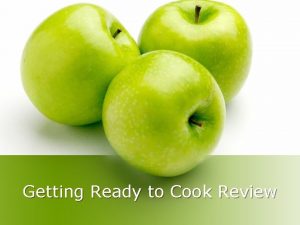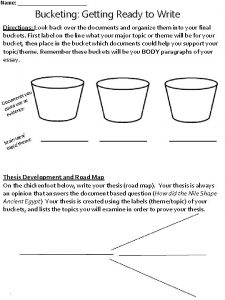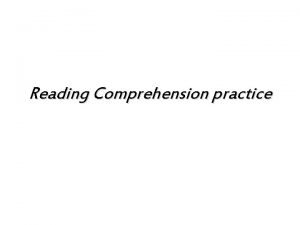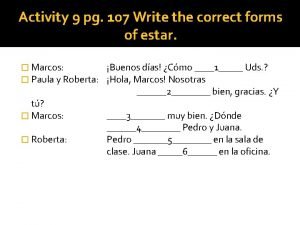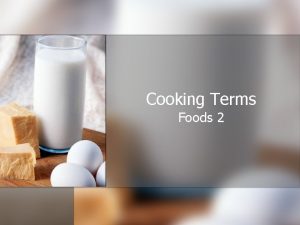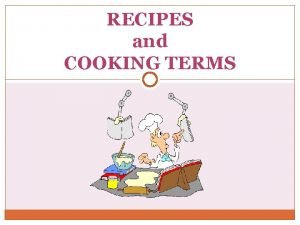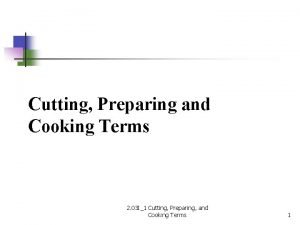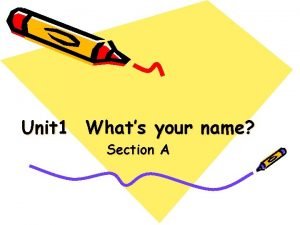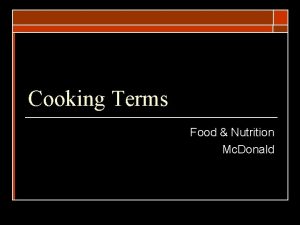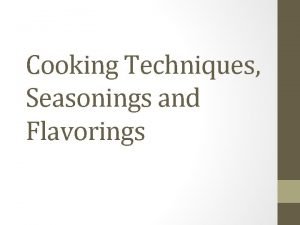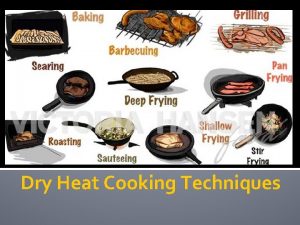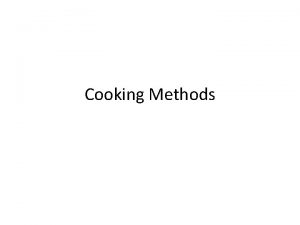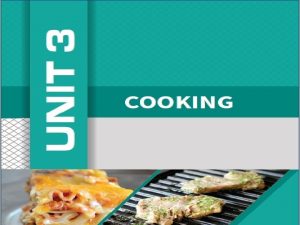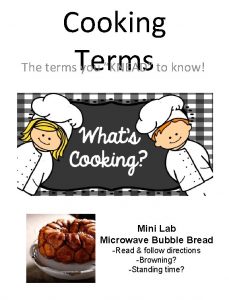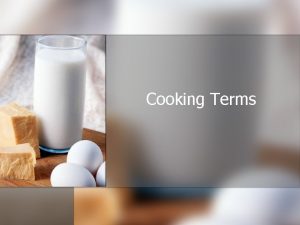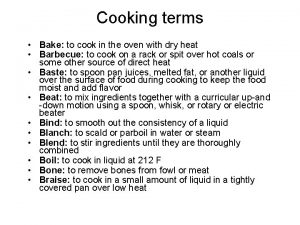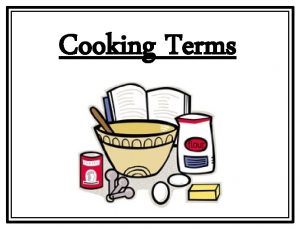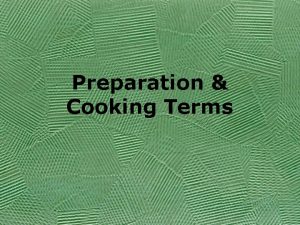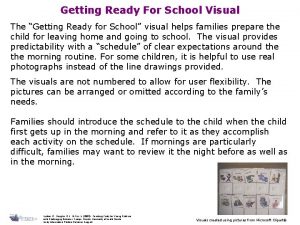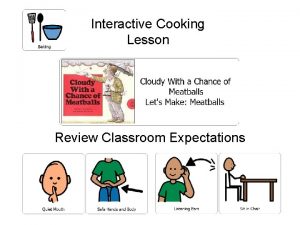Getting Ready to Cook Review Cooking Terms Know
























- Slides: 24

Getting Ready to Cook Review

Cooking Terms Know cooking terms: Sauté- Fry in small amount of fat until done Pre-heat- Heat the oven to the right temperature before putting in the food Boil- Cook in liquid hot enough to boil rapidly. Water reaches 212°. There should be a lot of little bubbles at the surface of the water Simmer- Cook to just below the boiling point so the liquid barely bubbles Steam- Cook over boiling water Fry- Cook in hot fat l

Preparation Terms l Know food preparation terms: Pare/Peal- to remove a thin layer of skin or peel from fruits and vegetables. Brush- use a pastry brush to lightly coat food with liquid before, during, or after cooking. Marinate- Place food in a container and cover it with a seasoned liquid for a period of time.

Food Cutting Terms Know food cutting terms: Mince- to cut into very tiny pieces. Grate- to break food into very fine pieces by rubbing food against a grater. Julienne- to cut into long, flat pieces. Chop- to cut into small, uneven pieces. Core- to remove the center or core of the food.

Abbreviations l Know abbreviations used in recipes C = cup oz = ounce l T = tablespoon pt = pint l lb = pound t = teaspoon l qt = quart gal = gallon l tbsp= tablespoon tsp = teaspoon l

Equivalents 1 tablespoon = 3 teaspoons l 1 cup = 16 tablespoons l 1 stick of butter = ½ cup l

Double a Ingredients/Recipe l Double ingredients: Use the least amount of steps for a more accurate measurement. ¾ cup sugar = 1 ½ cups sugar l 2 tablespoons butter = ¼ cup butter or 4 T. l 1 ½ t. salt = 3 t. salt or 1 T. l ¼ cup milk = ½ cup milk or 8 T. l

Reduce a Recipe in half. l Divide the following in half 1 ½ cups flour = ¾ cup flour l 1 T. salt = ½ T. salt l

Know Your Equipment Liquid Measuring Cup Slotted spoon Cheese Grater Colander ↑

Do You Know These Tools? Tongs Ladle l Strainer Cooling Rack l Double Boiler Vegetable Peeler l Measuring Spoons l Rubber Spatula l Dry Measuring cups l Rolling Pin l


Getting Ready to Cook l How do you set the table?

Kitchen Safety and Sanitation l What are guidelines that help ensure safety in the kitchen? l Clean as you go Know how to use the equipment and appliances Wipe up spills immediately Keep cabinet doors and drawers closed l l l

Safety and Sanitation l Why is it important to clean up spills from the floor immediately? l Wipe up spills immediately so nobody falls.

Safety and Sanitation l What are guidelines for handling knives? Don’t throw the dirty knife in the washing tub. l If a knife drops, let it fall. l Pass the knife with the blade down. l

Safety and Sanitation l When removing a lid from a pan, you should always do what? l Take the lid off completely away from you.

Safety and Sanitation l Describe how to extinguish a grease fire- besides using a fire extinguisher.

Safety and Sanitation l Food should not be left out more than 2 hours and every 20 minutes bacteria will double.

Safety and Sanitation What is a safe way to thaw meat? In the microwave or the refrigerator. l l How do you prevent cross contamination from occurring? Keep raw and cooked food separate. l To properly clean hands, how long should a person rub their hands together before rinsing them off? 20 - 30 seconds.

Safety and Sanitation l What are the four important things to remember when it comes to sanitation? l Clean Separate Cook Chill l

Safety and Sanitation l What are ways to know if food is cooked to a proper temperature and safe to eat? l Use a thermometer to check the temperature.

Good Information to Know. . . Refrigerators should be at 40 degrees or lower. Eatting raw cookie dough could lead to getting salmonella. What are three types of bacteria that we talked about in class? Salmonella, Ecoli, Staphylococcus (Staph) This type of bacteria is most commonly found in foods that have not been stored properly. Staphylococcus This type of bacteria is most commonly found in ground beef. E-Coli Lift the lids on hot pans AWAY from you.

Good Information to Know… l l l What are two safe ways to thaw frozen meat? Slowly n the refrigerator or in quickly in the microwave. Food containing bacteria that causes food borne does NOT always smell, look, or tastes bad. l Wash sharp knives individually l A hazard is a situation that could be dangerous. l If you drop a knife, let it fall.

Test is 30 pointsquestion will be worth l l l l l Each 1/2 point Equipment Identification -14 questions Kitchen terms - 8 matching questions Measuring Abbreviations- 10 questions Measuring Equivalents- 3 Questions Double ingredients – 4 questions Divide ingredients in half – 3 questions Kitchen and Food Safety- Fill in the Blank 5 questions Kitchen and Food Safety True or False- 5 questions Kitchen Safety – Write 8 tips How do you set the table?
 Getting ready to cook
Getting ready to cook Getting ready to cook
Getting ready to cook Stay ready to keep from getting ready
Stay ready to keep from getting ready The secret of getting ahead is getting started
The secret of getting ahead is getting started Market form of meat preserved by salting smoking or aging
Market form of meat preserved by salting smoking or aging Bucketing getting ready to write answers
Bucketing getting ready to write answers Superteachers.com
Superteachers.com Adult chatbot
Adult chatbot 1984
1984 The verb estar page 107 answers
The verb estar page 107 answers Unit 1 getting to know you ответы
Unit 1 getting to know you ответы Get to know you questions for adults
Get to know you questions for adults Cooking terms
Cooking terms Cooking terms jeopardy
Cooking terms jeopardy To finely divide food in various sizes by rubbing
To finely divide food in various sizes by rubbing Cut into long thin, flat pieces.
Cut into long thin, flat pieces. Know history know self
Know history know self Do deep generative models know what they don’t know?
Do deep generative models know what they don’t know? Nothing formed against me shall stand song
Nothing formed against me shall stand song Unit 1 introduction names and terms to know
Unit 1 introduction names and terms to know Electrician terms to know
Electrician terms to know Polynomial degrees and terms
Polynomial degrees and terms Finding like terms
Finding like terms Grandfather clause apush
Grandfather clause apush Iambic pentameter example
Iambic pentameter example
